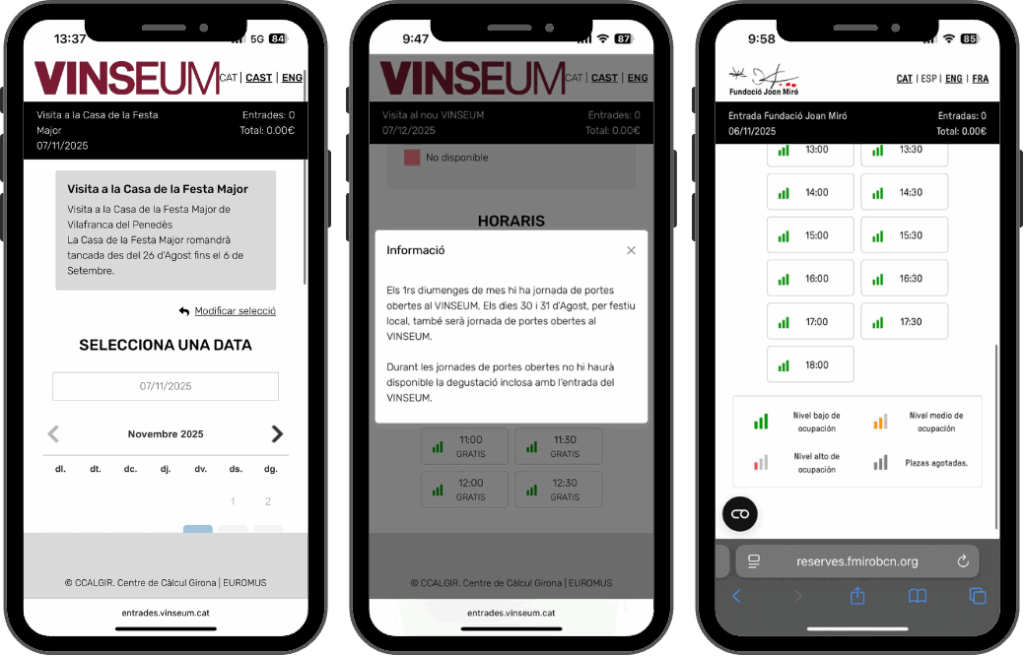UX/UI design is much more than a pretty layer. It’s how a digital product explains its functionality, guides decisions, and reduces noise.
When design and code speak the same language, the experience becomes a unique narrative: what you see is what happens, and what happens is what the product tells you.
This is the approach that, at DeMomentSomTres, we have applied to a leading cultural platform: Euromus, an online solution for selling cultural activities widely used in the sector, which trusted us to give it a strategic boost in terms of user experience, accessibility, and consistency across screens.
In this article, we share lessons learned that are useful for any team looking to improve their product with UX/UI design.
Euromus, a Benchmark that Gathers Insights
Euromus is not an experiment; it is a solution implemented in multiple cultural institutions. In fact, the platform’s analysis includes references to implementations such as VINSEUM and Fundació Joan Miró, among others, which demonstrate its scope and sectoral maturity.
When a solution of this magnitude requests an audit and improvement, the challenge is not to “reinvent” but to refine: to strengthen the product’s narrative so that the user proceeds confidently, and to ensure that the code consistently supports what the design communicates.
Therefore, in this post, we will include screenshots of two implementations that we know and value: VINSEUM (which is close to us) and Fundació Joan Miró (a benchmark institution for many members of our team). This material will help us illustrate patterns of good experience in real contexts.
What Does it Mean for Design and Code to Speak the Same Language?
Speaking the same language means that the user flow is clear from the first click, that the product’s rules are visible and understood, and that actions and states have a consistent visual representation. In practice:
- A single product narrative. The sequence of steps is understandable and predictable: date, activity, rate, and time slot selection. The user knows where they are and what comes next.
- Retained context. When the view changes, the user should not feel that the code governing the rules of the game has changed. Maintaining context and visibility of what has been chosen is essential for trust.
- Accessibility that adds value. Adequate contrast, textual information that complements icons, and clear semantics help everyone and, in turn, improve conversion.
- Consistency across screens and devices. What you learn in one step applies to the next and also on mobile. Consistency is part of UX/UI design, not an extra.

Our UX/UI Design Audit Approach
We approached the audit with a product-centric view: users, business objectives, and platform logic. The working documentation structures the analysis into context, UX, accessibility, responsive behavior, and improvement proposals, to ensure a holistic vision that can be implemented from day one.
From there, we converted the review into agnostic criteria (applicable to any technology). It’s not about “making it pretty,” but about formalizing design decisions into verifiable rules: step order, state persistence, consistent disabling of options, feedback close to the action, and help messages that explain what happened and how to resolve it.
Best Practices that Always Work
- Show the way before asking for actions. The calendar and activities must work together to reduce uncertainty: if a date is not valid, disable it; if an activity is not available, explain why. This prevents selections that lead nowhere.
- Feedback next to the action. Error or validation messages must appear where the user can act immediately, not at the very top or far from the field that needs correction.
- Text + icon = comprehension. Icons are useful, but accessibility improves when we add alternative text or labels that explain the function.
- Visual consistency = functional consistency. If a button means “advance,” it must always behave the same way and have the same visual code across all screens and devices.
- Avoid unannounced code changes. When a view changes rules or behaviors, the design must explain it. Predictability is a pillar of UX/UI design.

The Value of a “Strategic Boost”
Discussing UX/UI design with expertise means assuming that every micro-decision impacts trust and conversion rates.
When a platform like Euromus —present in various teams and institutions— seeks a second opinion, what we do is align the teams: ensuring that design, development, and business share the same mental map of the product.
That is, we document the flow, make the rules explicit, and reach a consensus on the visual semantics so that any subsequent evolution is more robust and faster to deploy. The result is greater clarity, less friction, and more inclusion: an experience where the user recognizes the pattern and proceeds confidently.
Conclusion
When design and code speak the same language, the product stops “demanding” attention and starts providing clarity. This is where UX/UI design unfolds its full value: it converts internal architecture into external understanding, and transforms technology into experience. In mature platforms like Euromus, this strategic boost is not cosmetic; it’s a way to continue growing on a solid foundation.
If you want us to review your digital product with this approach —where design becomes a clear specification for the code—, let’s talk.
